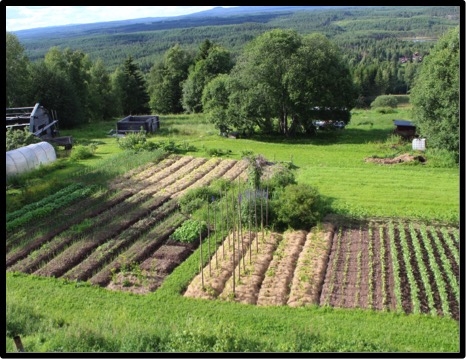The self-containing garden
It is sustainable and healthy to eat organic and locally produced food. Tellus Think Tank meets Patrik Ytterholm, who runs a self-containing garden…
Text: Domi, Tellus Think Tank Photo: Zoe Elims, Patrik Ytterholm & AnnVixen
During 2015 Tellus Think Tank began the search for what life might look like in a sustainable future. Our articles have since then investigated possibilities for a sustainable future, from different angles. Read more about Tellus Think Tank here.
After almost a year of conversations with people from different parts of society we understand that one aspect of a sustainable future is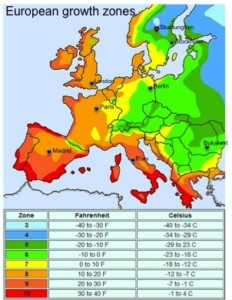 the move towards organic and locally cultivated food. Non-organic food that has travelled thousands of kilometres can never be sustainable.
the move towards organic and locally cultivated food. Non-organic food that has travelled thousands of kilometres can never be sustainable.
The food that we buy in supermarkets is seldom both organic and local and is also perceived as relatively expensive. Is there a solution to this? Could it be to cultivate our own food?
Tellus Think Tank is happy to meet Patrik Ytterholm, who runs a self-containing garden. He lives and cultivates his crops in Skattungbyn in the Swedish district of Dalarna, Sweden. The climate in Skattungbyn is considered to be growth zone 4-5 (by Swedish standards 6-7, the same growth zone as star restaurant Fäviken, see article).
Patrik Ytterholm is self-containing when it comes to his food
Patrik Ytterholm cultivates almost all of his own food and he also works full-time as a “cultivation” teacher at Mora Folkhögskola. (Read more about Skattungbyn here) and he also runs his own self-containing garden.
He is a vegetarian that appreciates a healthy meal containing pulse foods such as beans or peas, potatoes and leafy greens. Patrik sometimes ads a glass of goat’s milk or an egg to his meal and says that he in no way lives an ascetic life and he eats both sweets and crisps.
In practise, however, Patrik and his family are totally self-contained when it comes to vegetables. They run a self-containing garden. If
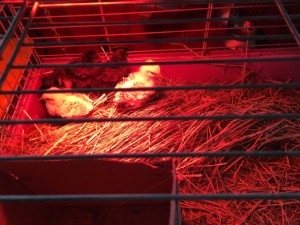
they were to be cut off from the world they would survive a long time on the food they grow and produce themselves.
The family cultivates slightly more land than necessary for their personal needs. Altogether they cultivate two hectares (20 000 square meters). 1000 square meters is used to grow vegetables and the rest to grow potatoes and different grains. Their surplus potatoes, cabbage and garlic are often sold at local markets.
The family doesn’t only grow their own food but chop their own wood to heat their home. They also have goats, chickens and soon even geese on their property.
Advice to persons that want to run an all year self-containing garden
We ask Patrik: -Which crops should one cultivate to become self-containing?
-A good start is to begin with potatoes. The downside is that to be all year self-containing potatoes need an earth cellar to keep fresh until next year’s crops are ready, he answers. (Also read Patriks advice on how to keep food all year by fermentation).
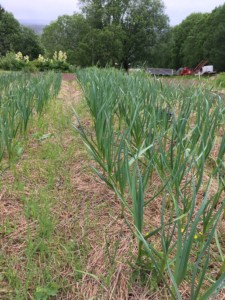
Other easy-to-grow crops like pumpkins, onions and garlic are easier to keep. Room temperature in an apartment will do.
An important pre-requisite to become self-containing is to have enough land to cultivate. Patrik says 1000-2000 square metres per person would be needed. On this land one could then cultivate vegetables, potatoes and different grains.
Families who want to cultivate their own oil plants (such as rapeseed or flax) would need another 500 square metres per person.
One type of grain he recommends is ”naked oats” that can either be pressed to oats or replace rice in meals. Naked oats are also gluten free. Other good alternatives are the normal European grains: wheat, rye, barley and normal oats.
To persons with a confined space to cultivate Patrik recommends growing crops that are difficult to find in stores, for instance broad beans. He also recommends kale, as it is very nutritious.
Patrik comes back to potatoes that he finds are a diversely nutritious food containing fibres and vitamins and gives a feeling of satisfaction. He grows his own potatoes in sand rich land:
-My potatoes taste heavenly, he smiles!
Oil plants in a more northern growth zone
One oil plant that Patrik considers to be the most interesting is Sea-buckthorn. The Sea-buckthorn berry carries Omega 6, 9 and 11. Omega 11 is not easy to be found in any other plant. The berries are also full of other nutritious substances but Patrik is not sure how
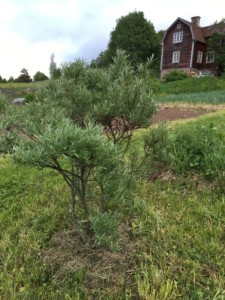
the Sea-buckthorn oil would be suited in cooking.
Sea-buckthorn can be found wild along the coasts of Sweden. Patrik has cultivated five bushes in his garden that give him about 70 litres of berries per season!
Rapeseed is a widely spread crop throughout the southern parts of Sweden but is difficult to cultivate in Skattungbyn as it isn’t suited for the climate zone.
Hemp is an oil plant that could be of interest in more northern growth zones. Hempseed oil has comparable qualities and omega acids to olive oil. Swedish authorities are still very careful about issuing permits to grow hemp because of the risk of the plants being used illegally. Since the summer of 2016 hempseed oil can be bought in supermarkets through out the country.
Further oil plants recommended by Patrik are turnip rape, gold-of-pleasure (latin: Camelina Sativa) and sunflower.
How much time would one need to run a self-containing garden?
Another important aspect of becoming self-containing is how much time one needs to invest to become successful. Patrik walks us
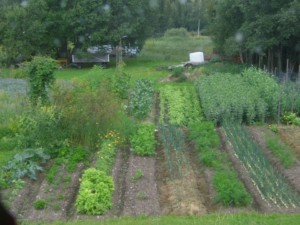
through the summer half year:
April
April is normally spent preparing for the season to come but is far from the most busy month of the year.
May to June
Patrik spends all of his free time from May to the end of June sowing and planting pre-cultivated plants. During this period he and his family also prune their berry bushes and rebuild their greenhouse.
From about the 20th of May it is possible to put a spade into the ground for the first time after winter and that is when work with their cultivation becomes intense, it goes on until midsummer (about 20th of June).
July and August
From midsummer the workload is limited to normal garden upkeep such as watering and weeding.
In July the hay needs to be harvested (often herbs of clover and timothy. The hay is dried on traditional drying racks and will be feed to the family goats during winter.
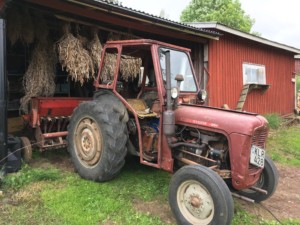
August is one of the calmest months and the family continuously harvest crops like broccoli, peas, beans and other vegetables. One way of keeping busy during this period is to ferment and pickle the harvested vegetables, so that they can be enjoyed all year around.
End of the year
The really intense harvesting begins in the last week of September, when most of the crops need to be brought home. Patrik has a threshing machine and an old tractor to help him save time on his grain fields.
The lightweight tractor doesn’t press too hard on the ground, which could affect the growth power and earth climate for the important micro-organisms. It is old enough and mechanically driven and Patrik can fix it by himself.
The winter half year as a self-containing farmer is relatively quiet.
Patriks self-containing household is organically driven
Patrik tells us that the family only run organic cultivations. I wonder how they handle different pests and problems, when some farmers use chemicals and pesticides.
-Mechanical arrangements are the best, says Patrik, as they close the door to the problem from the beginning.
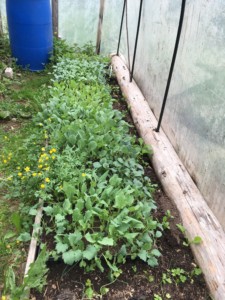
One pest that Patrik handles mechanically is the Carrot Psyllid flea and he does so by covering his carrot beds with a fibre cloth.
If the birds are eating his crops he covers them with a net.
Help good species live in the garden
Other ways to avoid pests are to invite predators like toads, birds and different insects and in this way create a natural balance. He says that invitations can be to put up birds nests or to keep trees, bushes and leave the grass high. Plant flowers in and around the cultivations and leave heaps of stone by the cultivations instead of cleaning them away. By taking these measures a gardener creates both protection and places for the right species to live in the garden.
Patrik says that ”biological” pesticides such as Turex, are supposedly environmental friendly. Turex is used to kill cabbage butterfly larvae on white cabbage and broccoli but unfortunately it also kills all kinds of butterfly larvae. He therefore try’s not to use these kind of biological pesticides at all.
Keeping vegetables all year
Patriks Sea-buckthorn bushes give 70 litres of produce and an array and huge amount of vegetables ripening during late summer and autumn. How does the family contain all the food they produce?
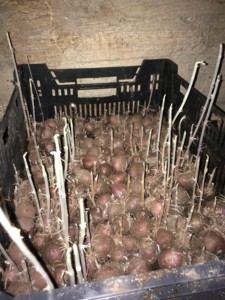
-We have an earth cellar and we have a really big freezer. We make herbal salts or dry our herbs to make tea or spices. Some of our vegetables are pickled and are preserved to last throughout the year.
Fermenting or pickling vegetables is a good way of containing vegetables with the help of a fermentation process that increases lacto acid in the vegetables. Patrik ferments white cabbage into sauerkraut and pickles all kinds of vegetables such as broccoli, cucumber and peas. In short the vegetables are salted and put into fermentation pots and preserved in the earth cellar or in the fridge.
Patrik’s favourite pickle is a mixture of carrots and turnips. (See Patrik’s recipes).
The earth cellar
They keep a lot of their vegetables in the earth cellar, root vegetables such as potatoes and turnips but even cabbage and leeks. The best way to keep cabbage fresh through the winter is to hang them by their roots, upside down, so that the fluid from the vegetables are contained in the leaves. As Patrik’s household produces large amounts of vegetables there is not always room to hang all the cabbage so they are kept in weave sacks in wooden boxes, a method that works well! They keep their leeks by a technique called “heel”.
The earth cellar needs to be 2 – 4 degrees Celsius or else the vegetables will sprout. During the last couple of years it has been difficult
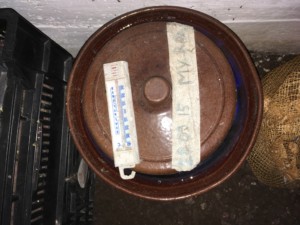
to hold earth cellar temperatures as winters have been too warm.
Improving depleted soil
If you want to run your own self-containing garden this might interest you. Patrik mentions an example in Skattungbyn where a new farmer intends to cultivate her crops organically and expects that it will take up to 7 years before the depleted soil is giving a good amount of produce. Depleted soil comes from, among other things, bad crop rotation.
Patrik tells me that it is important to feed the micro-organisms in the depleted soil with both food and oxygen. The food of the micro-organisms is organic matter such as fertilised dung, grass cuttings or compost.
Green manuring
The soil also needs to have its oxygen levels increased, which can be done by “green manuring”. With the green manuring technique special crops are planted to help loosen the soil and reach for nutrients in the ground that other plants can’t reach. The green manuring plant clover also helps bring nitrogen out of the air and move it into the soil.
Nitrogen, phosphorus and potassium are three of the most important nutrients in soil that help the micro-organisms to thrive, but there are many more elements needed.
Swedish soil is very poor in selenium, which is a vital substance for the survival of both animals and humans. Selenium can be added to the soil in form of a stone dust, which will maturate during several years and be absorbed by the plants. Another way is to take selenium nutritional supports.
The value of being self-sufficient in vegetables
Patrik’s own rough estimate shows that the families self-containing garden annually grows crops for a store value of 70 000 Swedish kronor (about 7000 Euros/Dollars). It feels meaningful for the family to continue to grow their own food as it is not only organic but also locally and self-cultivated! It also tastes much better than food bought in a supermarket.
Mora Folkhögskola holds practical courses in cultivation
The cultivation course that Patrik teaches starts in January and continues through the year so that students can learn both theory and practise about sowing, harvesting and preserving food.
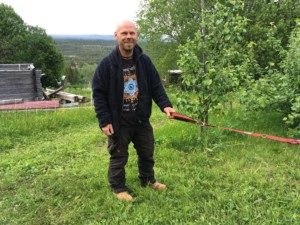
Each student has access to 150-200 square meters of land during training so they can grow cereals, potatoes and a variety of different types of vegetables.
Patrik has taught at the school for almost twenty years and says he sees a difference in today’s students compared with the students who attended in his early teaching days:
-The students of today aren’t used to hard labour and have little, or no, practical experience from chores such as chopping wood, forestry or gardening. In a theoretical sense they are very knowledgeable, thanks to the Internet.
The year attending the cultivation course gives many an opportunity to familiarise themselves with their own physical capacity. Patrik says that working with cultivations is not always a party, but it is always meaningful and worthwhile!
The start of Patrik’s interest in cultivating
Patrick grew up in a home that he calls old-fashioned. His parents used traditional ways to did most things with their food and tools by own hand. One of the things that still drives Patrik is to take responsibility for his life and footprint on Earth.
In his twenties, about 20 years ago, he realised that it was more fun to work towards something than be against something. He joined a
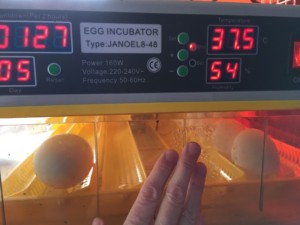
relief organisation aiding people in need. In this role he met many who were involved with farming and cultivation and became so interested that he signed up for a cultivation course.
Soon, he cultivated large amounts of his own food on 200 square meters of allotment plots. He also started working for an organic farm with a self-containing garden. Patrik felt from the start that he was cultivating his food for real, not just for fun and he soon had his own self-containing garden!
The move to Skattungbyn
Food cultivation was also a central motive when he moved to Skattungbyn in 1995. The village offered him the possibility to grow his own food. After a few years in the village the founder of the cultivating course at Mora Folkhögskola, Kåre Olsson, wanted to retire and Patrik was asked to replace him!
To Patrik it is important that he can create things himself including the food needed in his life. If he can’t do it himself he happily turns to a friend and only buys things in a shop as a last resort.
-It feels more meaningful when I have a relationship with the person who created the things I use or the food I eat, says Patrik.
Some final words from Patrik for this time
-For me it is valuable to be able to grow my own food, and if more people cultivated their own food it could help a lot to reduce the negative impact on the climate.
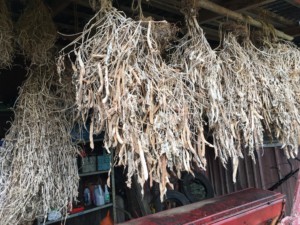
It would be great if we could reduce the number of hands (intermediates and transport) handling our food. We currently use more energy to transport food than the food feeds us, which isn’t environmentally friendly.
The best soils in Sweden are currently used for animal grazing instead of growing food. We need to think this through. Animals could successfully graze in forestlands instead of on the best farmlands so that we can use the farmlands to grow more food.
Keeping goats
Keeping goats, for milk, is a much more climate friendly choice than keeping cows. Goats find food everywhere and give a lot of food in relation to the energy that their keep demands. Goats don’t pull grass out by the roots as cows do, and can even serve as lawnmowers! Patrik’s goats have a schedule to visit different gardens around the village of Skattungbyn, to keep the goats fed and the grass short!
Our visit to Skattungbyn and our conversation with Patrik has been interesting, instructive and inspiring. Tellus Think Tank understands that even if not every city dweller can grow their food in a self-containing garden perhaps locally grown crops could still be a path towards a sustainable future!
We recommend further readings if you are interested in organic food or running your own organic and self-containing garden:
Patriks recipes on how to ferment vegetables for all year consumtion
Living in Tiny homes on wheels
Try an alternative way of living
Plantagon might soon produce locally grown food close to you
Star restaurant Fäviken serves organic meals

Please share this article – for a sustainable future!
